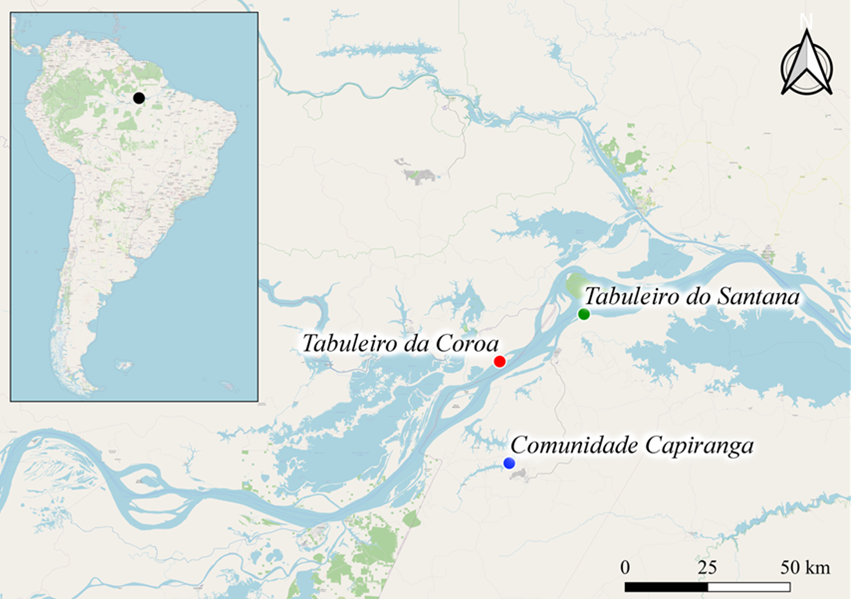Introduction
The ability to identify individual animals is important for the study of demography and population structure, being necessary for monitoring populations over long periods of time (Broderick & Godley, 1999). Freshwater turtles are they are usually marked individually by making notches on the marginal scutes of their carapace in different combinations so that later identification can be made (Cagle, 1939). By providing more accurate and detailed data, researchers can better identify and protect areas of critical habitat, as well as develop more effective management strategies for rare or endangered species.
Freshwater turtles can have with a wide distributions, such as species within Podocnemididae family (Ferrara et al., 2017). Especially for Amazonian freshwater turtles, such as species of the genus Podocnemis there are numerous difficulties encountered in population monitoring studies, specifically in the capture-mark-recapture method, since what is currently available is not as efficient and/or the difficulty of the methodology used in field studies makes its use unfeasible. In addition, the difficulty of accessing remote areas, as in the case in some regions of the Amazon, and the lack of infrastructure in such areas, makes it difficult to collect data on turtles in a timely and cost-effective manner (Cunha et al., 2019). The lack of resources and expertise in research and conservation of turtles in the Amazon makes it difficult to develop effective management strategies for the species (Bernhard & Vogt, 2012). Furthermore, the lack of comprehensive data on the abundance and distribution of turtles in the Amazon makes it difficult to assess the impact of human activities on turtles (Fagundes et al., 2018).
The standard marking method used in turtle population research and monitoring is to mark the marginal scutes of the turtles carapace (Cagle, 1939 adapted in Bernhard et al., 2016; Balestra et al., 2016). This method is commonly used for studies documenting population demography of freshwater turtles of South America (Vogt, 2008; Bernardes et al., 2014) and involves making notches or holes in the marginal scutes to generate a unique code for each individual. In Brazil, following technical protocols and recommendations from regulatory agencies for studies involving wild animals, due to the biological characteristics of turtles, of the 12 marginal scutes of the carapace, it is possible to mark eight of these scutes only, which reduces the number of possible numerical combinations (Balestra et al., 2016).
Another limitation of using notches or holes is the difficulty of standardizing codes used for individual identification (Balestra et al., 2016). For instance, such a method may not be practical for monitoring the critically endangered species, Giant South American River Turtle (Podocnemis expansa (Stanford et al., 2020), widely distributed in South America. This species occurs across seven countries in a total area of almost 3 million squared kilometers (Forero-Medina et al., 2019; Rhodin et al., 2021) and is the subject of various conservation projects/programs at local scales.
Another widely used method for studies of capture-marking-recapture to understand the population structure of species is the use of plastic and/or metal tags with unique and individual numbering (Balestra et al., 2016). However, plastic ones are fragile and over time they detach from the animal, losing information. (Bjorndal et al., 1996; Limpus, 1992). It is common for metal tags to break as the animals body grows, making it difficult to monitor individuals long-term (Reisser et al., 2008).
The method of individual marking with cattle ear tags has already been used in other parts of the world (Plummer & Ferner, 2012; Ferner, 2007; Doody & Georges, 2000). We tested this use of the method of individual marking to test on Amazonian species, specifically turtles in the Podocnemis genus.
Materials and methods
Study site
Turtle captured was conducted between Oct/2018-Oct/2020 in the Municipality of Juruti, in the Lower-Amazon Region, Northern Brazil, as part of the Juruti Municipal Freshwater Turtles Management Program (PMQJ). The trials were carried out in three areas (Figure 1): In “Tabuleiro do Santana” Turtle Nesting Area (Site 1; 02° 3'19.23"S, 56° 0'52.66"W); Coró-coró Community - “Tabuleiro da Coroa” Turtle Nesting Area (Site 2; 02°11'1.72"S, 56°14'45.11"W); and, Capiranga Community Turtle Nesting Area (Site 3; 02°27'37.02"S, 56°13'13.07"W). The “Tabuleiro do Santana” and “Tabuleiro da Coroa” sites occur on the banks of the Amazon River and are characterized by whitewater whereas the Capiranga Community site is a clearwater lake environment. Turtles were captured using trammel-nets (Vogt, 1980) as well as by active searching on terrestrial areas during nesting (manual capture; Vogt, 2012), with tagging was undertaken immediately after oviposition.
Target species
We selected four species which that are currently the focus of management and conservation efforts: Giant South American River Turtle (Podocnemis expansa); Yellow-spotted River Turtle (Podocnemis unifilis); Six-tubercled Amazon River Turtle (Podocnemis sextuberculata) and, Red-headed Amazon Side-necked Turtle (Podocnemis erythrocephala). These four species represent the most abundant turtles in the in the Amazon River Basin. At sites 1 and 2, our capture effort focused on manual capture, as P. expansa is more social during the nesting period, which allows for greater capture due to the abundance and concentration of females. For site 3, individuals were captured with a specific trammel-nets for the focal species, positioned in front of the nesting areas of the species P. unifilis, P. sextuberculata and the P. erythrocephala. For this reason, males were less represented in captures.
Methodology used, marking time and period of use
Turtles were tagged between 18 October 2018 and 22 October 2020. Owing to the nesting period of turtles ranging from August - December (during periods of the lowest water levels in the Brazilian Amazon), management activities and conservation actions are intensified in this same period, thus our research was focused during in the months of the second half of the years. The allocation of the tag+pin takes just a few seconds after making the hole, which can be done manually (with a gimlet) or with the help of a rechargeable electric drill.
Data collection
For each turtle captured, we identified sex or juvenile (when the individual did not present secondary sexual dimorphism), and measured the curvilinear carapace length (CL, in cm) and weight (in Kg). Photographs in dorsal and ventral positions were take of each individual.
Tagging
Ultraviolet resistant and inviolable plastic tags made of high-quality thermoplastic polyurethane, commonly used for marking cattle, were applied to each turtle (AnimallTAG, Animal TAG®, Korth RFID Ltd., São Carlos, São Paulo, Brazil). These tags are vibrant yellow with a unique three-digit laser-printed number, measuring 40 x 42 mm with a 28 mm diameter fitting pin (Figure 2A, B, C). In addition to numbering, we include the municipality where the animals were captured and marked, in addition to the initials of the management program and the institution (e.g., Figure 2C - Juruti, PA, 198, PMQJ/SEMMA). All captured turtles were marked, in addition to these, some seized turtles were marked after being returned by the inspection body when the origin was known, in this case, “Tabuleiro do Santana” (three specimens of P. unifilis). In order to apply the tag and pin fitting set, a small hole in the marginal region of the carapace was made using a drill (4 mm the size) (Figure 2D, E, F, G). This method is minimally invasive causing no injury to the animal. A study conducted by Doody et al., (2002) with the Australian softshell turtle (Carettochelys insculpta) employed a similar method. This research was licensed and authorized by the Biodiversity Authorization and Information System- SISBIO n( 59171-2.
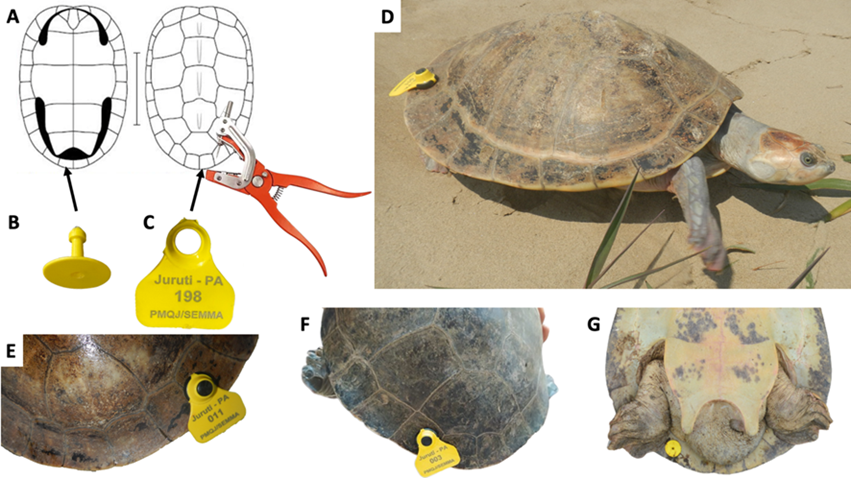
Photos: Fábio Cunha.
Figure 2 A - Schematic design for using the method. B - Tag snap pin. C - Tag with information on the location of the Project/conservation program with the individual number of the captured animal. D - Lateral view of an adult female of Podocnemis sextuberculata marked with the method tested in Tabuleiro Santana, in western Pará, municipality of Juruti, Pará, Brazil. E - Dorsal view after application of the tag+pin on the species P. sextuberculata (adult female). F - Dorsal view after application of the tag+pin fitting in the species P. unifilis (adult female). G - Ventral view for the animal with the tag+pin fitting in the species P. expansa (adult male).
Results
Turtle trapping and tagging
We captured 105 turtles (16 males, 88 females, and one of undetermined sex - juvenile) of the four study species (Table 1; Figure 3). The most abundant species caught was Podocnemis expansa (57 individuals; Figure 4), followed by P. sextuberculata (30 individuals) and then, P. erythrocephala and P. unifilis (nine individuals each; Figure 5). The “Tabuleiro da Coroa” had the highest number of captured animals (50 individuals of P. expansa only), followed by the Capiranga Community with 46 individuals of all studied species. The “Tabuleiro do Santana”, had nine individuals captured of three species (P. unifilis, P. expansa, and P. sextuberculata). Throughout the study, females were more abundant across all sites (Table 1). Recaptures were not actively sought, however, for the three study sites with tagged animals, riverside dwellers reported that animals were seen with tags intact during 2020. For site 1, 12 female turtles (P. expansa) were seen nesting again in subsequent years; for site 2, two females of P. unifilis were captured by riverside dwellers and returned to the environment. For site 3, no recaptures were noted.
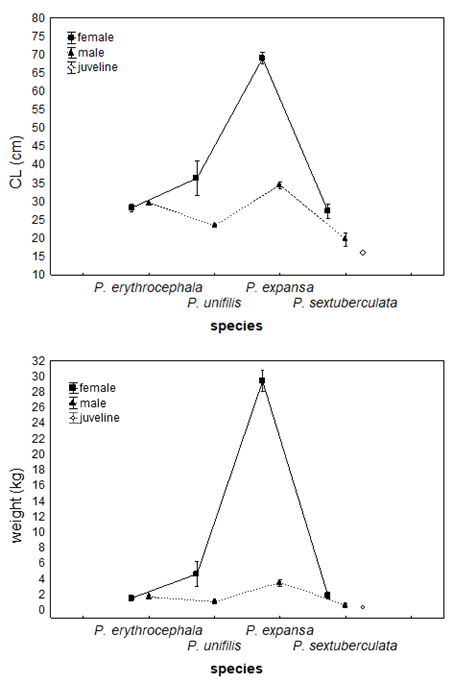
Figure 3 Comparison of carapace length (CL) and weight of captured and tagged animals for the four studied species, evidencing the differentiation between males, females and a juvenile individual.
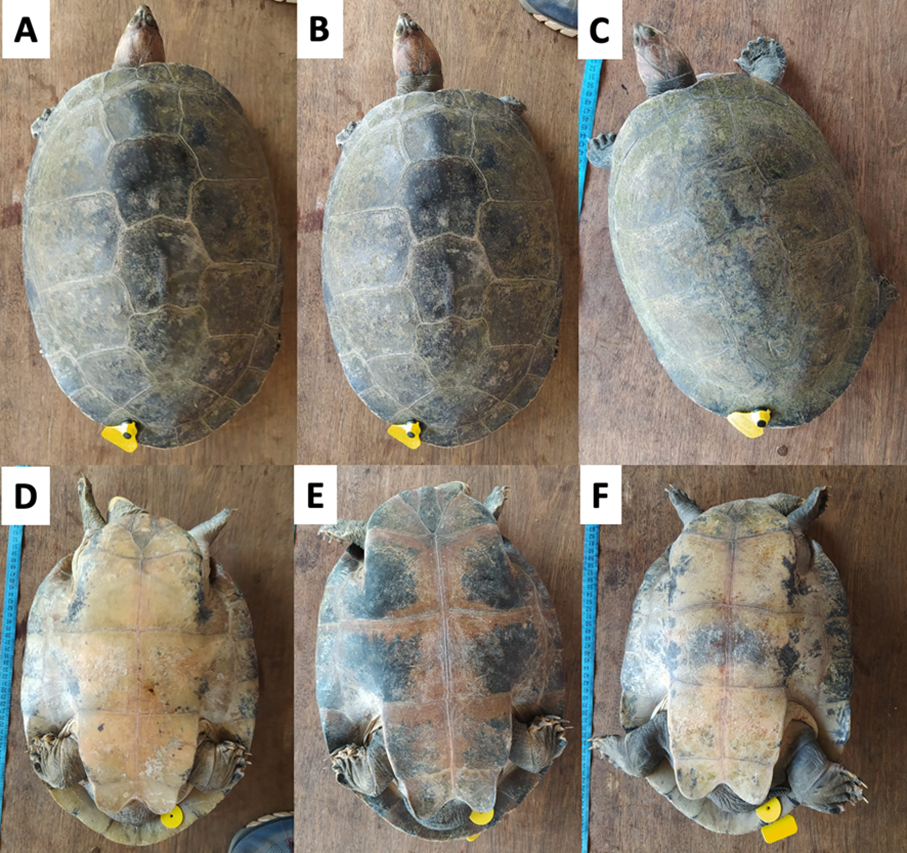
Photos: Fábio Cunha.
Figure 4 A, B, C - Dorsal view of adult female of Podocnemis. unifilis marked with the tested method. D, E, F - Ventral view of adult females of P. unifilis marked with the tested method, in western Pará, Brazilian Amazon.
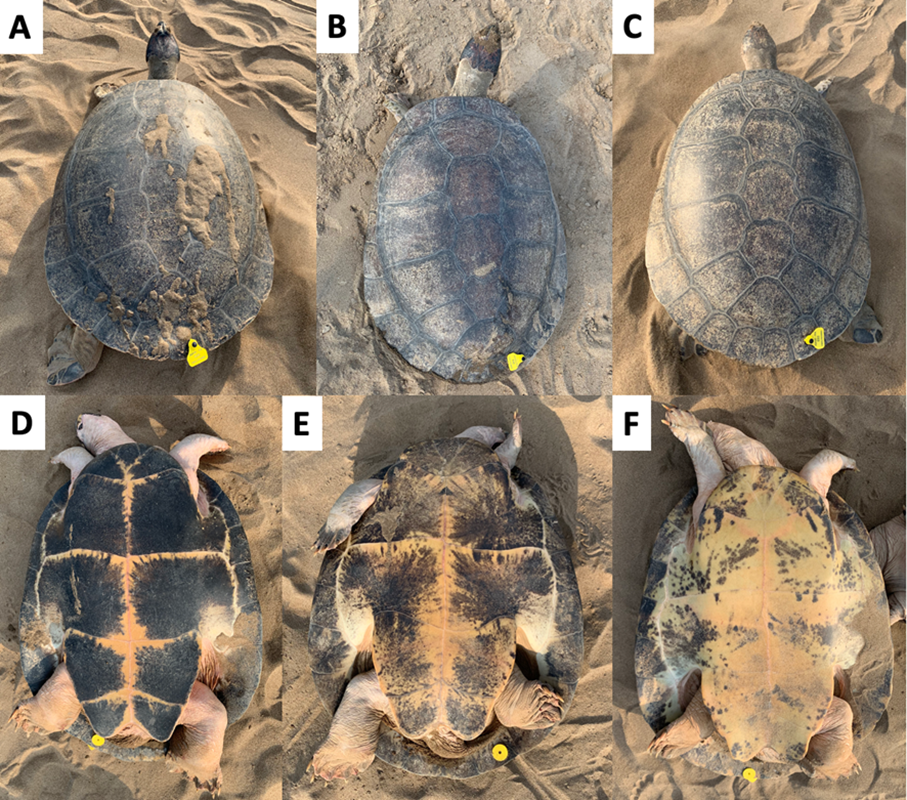
Photos: Fábio Cunha.
Figure 5 A, B, C - Dorsal view of adult females of Podocnemis expansa marked with the tested method. D, E, F - Ventral view of adult females P. expansa marked with the tested method, in western Pará, Brazilian Amazon.
Table 1 Measurement data for the four species of Podocnemis turtles captured and tagged in the western region of Pará, Brazilian Amazon.
| Species | N (F/M/J) | weight (Kg) | Carapace length (cm) | ||||
| Mean ± SD | Min | Max | Mean ± SD | Min | Max | ||
| P. erythrocephala | 9 (8/1/0) | 1.5 ± 0.1 | 1.3 | 1.7 | 28.3 ± 1.1 | 27.1 | 30.7 |
| P. unifilis | 9 (8/1/0) | 4.2 ± 2.0 | 1.1 | 6.7 | 34.9 ± 6.8 | 23.4 | 41.0 |
| P. expansa | 57 (52/5/0) | 27.1 ± 8.7 | 3.0 | 44.6 | 64.0 ± 12.8* | 33.5 | 80.0 |
| P. sextuberculata | 30 (20/9/1) | 1.4 ± 0.8 | 0.3 | 3.2 | 24.6 ± 5.2 | 15.5 | 33.5 |
| Total | 105 (88/16/1) | ||||||
* 35 animals measured.
Discussion
Cost-benefit analysis
Finally, the results of our analysis can be used to inform decisions about the allocation of resources for future projects. By understanding the cost-benefit of different projects, managers can make more informed decisions about which materials are most cost-effective and efficient for a given project. This can help to ensure that resources are allocated in the most efficient and cost-effective manner possible. In this regard, cost was calculated as the dollar value of material used in the field for marking the animals only without taking into account peripheral costs such as training, time to analyze or summarize field data, per diems for travel and vehicles or expenses general and indirect. As the method is simple to use and does not require much team training, associated with the low cost of the materials used, it was evaluated positively. And, widely recommended for conservation projects or programs with large freshwater turtle species.
Time invested and material safety
On 23 October 2020 it was possible to mark 30 adult females of P. expansa in just one morning, obviously, there is more time devoted to collecting biometric data from animals, demonstrating the agility and speed with the applied marking. Turtles tagged in 2018 were recaptured in 2020, demonstrating that the method and material can last multiple years. However, marked species three perform oviposition in isolation and during the night, which may have hindered the occasional encounter with the riverside dwellers; however, it should be noted that in all encounters/recaptures, the tags were intact and with legible and preserved information.
It is conceivable to think that one type of tag is better suited to one species population and others to other populations (Mrosovsky, 1976). Here we present the first results of our method used demonstrating the effectiveness of individual identification method in Podocnemis turtles in the Brazilian Amazon. Our method provided an excellent alternative to notching marginal scutes given the demonstrated success in the field at low cost (0.3 USD for each tag). Our tagging method is relatively cheap. Cost is often a barrier in science and this method provides a useful alternative.
The ability of our method to easily involve citizen scientists also adds extra value to our technique. In other words, citizen scientists can document revisited animals, providing cost savings in conservation projects. The saved resources can be redirected towards alternative field research requirements. Additionally, it can serve as a fruitful incentive for young individuals and turtle enthusiasts to engage in studies and scientific research. Furthermore, the notching turtles is more costly as the turtle has to be recaptured so that the shells can be examined for individual identification. For the next steps for research using the method presented here, citizen scientists can visualize the turtles and inform the animal number (like through the numbered cattle tags have in this study), not being necessary to recapture the turtles becomes less invasive and less stressful which represents gains during behavior studies. Regarding the fact that animal recapture is not necessary, it is possible to associate the method presented here with photography and/or videos using drones to identify the marked animals during nesting or basking (Fagundes et al., 2022).
The size and shape of the tag and pin used in our study were effective for the purpose of marking species of the genus Podocnemis. The yellow tags made it easy to read; in some cases, perhaps basking turtles can be monitored without the necessity of capturing - perhaps camera traps on basking areas could be a method of monitoring turtles. Other models of varying size and shape are available meaning that this method can likely be used for other species, such as those in families Geoemydidae and Chelidae.
In our preliminary study, the labels used displayed a set of codes (location, animal identification number -3 digits-, and project name), totaling 22 characters. In other words, it is possible to use the entire label space for the animal identification code. It is also possible to customize the label color by defining, for example, the marking year, sex, or a sub-population of the same species. This makes it easier to identify and study the behavior of the animals. In our study, we presented only one label model (vibrant yellow).
Although there are existing methods that also use plastic labels, our method was superior due to the security of the material, efficiency of information transfer, and easy attachment to turtles. We captured many female turtles, demonstrating that in large river systems, such as the Amazon River, the marking method we use is useful as it allows us to collect information during the nesting period. Our tags also allowed us to observe/obtain individual information and behavior of the females without capturing them, thus, without interfering in the oviposition process.
For many Podocnemis species the recapture rate is relatively high (Bernhard & Vogt, 2012) which makes it necessary that the marking method used is safe for years of studies. One primary issue for turtle research and monitoring is ensuring the longevity of individual marking (Munscher et al., 2022).
There are population demography studies that reported the loss of biological information due to the method employed. For instance, Bernhard & Vogt (2012) when studying P. erythrocephala in the Negro River basin, reported that marked and recaptured animals had broken marginal scutes, which made it impossible to use the information in the study. This problem was not observed in the present study, despite the short time, since the holes were made in the inner region of the marginal scute of the carapace, therefore, it is not possible for the scutes to be broken, potentially.
In species of large turtles that appear on the critically endangered species lists, such as P. expansa (Stanford et al., 2018, 2020), P. unifilis, P. sextuberculata and P. erythrocephala, which are classified as vulnerable by IUCN (Rhodin et al., 2021), with many gaps about their ecology, it is imperative that field studies are leveraged to produce more information on habitat use, home range, dispersal, movement patterns and migration (Cunha et al., 2021). In this sense, efficient methods must be used which lead to more individuals marked within a short time, generating more biological information about the studied species, resulting in changes in conservation strategies and actions.
Our method presents a viable alternative for longterm population demography, monitoring and conservation projects/programs of endangered species. As new information is needed on the long-term duration and safety response of the material used over the next few decades, we encourage more researchers to use the presented method for other regions of South America.
It is undeniable that Passive Integrated Transponder (PIT) tags are the safest and highly efficient method (Huestis & Meylan, 2004). However, this method is incompatible with the financial and resource nature of conservation projects in the Brazilian Amazon (more than five USD each, with current quotation in BRL; not to mention the microchip reader). Currently, over 80% of all reproductive sites of turtles in the Brazilian Amazon are managed by community-based conservation and management projects (Andrade et al., 2022). In other words, with budget limitations, some regions carry out activities with the bare minimum, and in some cases, there are insufficient resources even to cover the volunteers' food expenses.
Given this scenario and in search of an alternative for the minimum standardization of marking for managed turtles, an individual marking method is being sought. Furthermore, numerous studies and population assessments of freshwater turtles worldwide, including in the Brazilian Amazon, have been conducted using the traditional notch markings on the carapace (with some regional adaptations - Bernhard & Vogt 2012; Bernardes et al., 2014; Balestra et al., 2016; all following Cagle, 1939). While it is widely acknowledged as a cost-effective method that has been useful for decades, the scientific and conservation community should actively seek and present alternatives to enhance the efficiency of conservation tools.
Conclusion
The method presented is a suitable, simple, cost-effective, and less invasive alternative, as turtles do not necessarily require recapture for individual identification. At this initial stage, the method has proven to be effective for application in species of the Podocnemis genus in the South American region, especially in northern Brazil.












 uBio
uBio 

